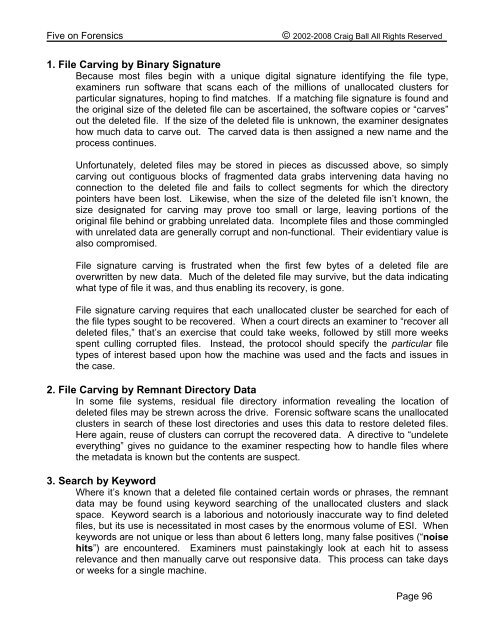Five on Forensics Page 1 - Craig Ball
Five on Forensics Page 1 - Craig Ball
Five on Forensics Page 1 - Craig Ball
Create successful ePaper yourself
Turn your PDF publications into a flip-book with our unique Google optimized e-Paper software.
<str<strong>on</strong>g>Five</str<strong>on</strong>g> <strong>on</strong> <strong>Forensics</strong><br />
© 2002-2008 <strong>Craig</strong> <strong>Ball</strong> All Rights Reserved<br />
1. File Carving by Binary Signature<br />
Because most files begin with a unique digital signature identifying the file type,<br />
examiners run software that scans each of the milli<strong>on</strong>s of unallocated clusters for<br />
particular signatures, hoping to find matches. If a matching file signature is found and<br />
the original size of the deleted file can be ascertained, the software copies or “carves”<br />
out the deleted file. If the size of the deleted file is unknown, the examiner designates<br />
how much data to carve out. The carved data is then assigned a new name and the<br />
process c<strong>on</strong>tinues.<br />
Unfortunately, deleted files may be stored in pieces as discussed above, so simply<br />
carving out c<strong>on</strong>tiguous blocks of fragmented data grabs intervening data having no<br />
c<strong>on</strong>necti<strong>on</strong> to the deleted file and fails to collect segments for which the directory<br />
pointers have been lost. Likewise, when the size of the deleted file isn’t known, the<br />
size designated for carving may prove too small or large, leaving porti<strong>on</strong>s of the<br />
original file behind or grabbing unrelated data. Incomplete files and those commingled<br />
with unrelated data are generally corrupt and n<strong>on</strong>-functi<strong>on</strong>al. Their evidentiary value is<br />
also compromised.<br />
File signature carving is frustrated when the first few bytes of a deleted file are<br />
overwritten by new data. Much of the deleted file may survive, but the data indicating<br />
what type of file it was, and thus enabling its recovery, is g<strong>on</strong>e.<br />
File signature carving requires that each unallocated cluster be searched for each of<br />
the file types sought to be recovered. When a court directs an examiner to “recover all<br />
deleted files,” that’s an exercise that could take weeks, followed by still more weeks<br />
spent culling corrupted files. Instead, the protocol should specify the particular file<br />
types of interest based up<strong>on</strong> how the machine was used and the facts and issues in<br />
the case.<br />
2. File Carving by Remnant Directory Data<br />
In some file systems, residual file directory informati<strong>on</strong> revealing the locati<strong>on</strong> of<br />
deleted files may be strewn across the drive. Forensic software scans the unallocated<br />
clusters in search of these lost directories and uses this data to restore deleted files.<br />
Here again, reuse of clusters can corrupt the recovered data. A directive to “undelete<br />
everything” gives no guidance to the examiner respecting how to handle files where<br />
the metadata is known but the c<strong>on</strong>tents are suspect.<br />
3. Search by Keyword<br />
Where it’s known that a deleted file c<strong>on</strong>tained certain words or phrases, the remnant<br />
data may be found using keyword searching of the unallocated clusters and slack<br />
space. Keyword search is a laborious and notoriously inaccurate way to find deleted<br />
files, but its use is necessitated in most cases by the enormous volume of ESI. When<br />
keywords are not unique or less than about 6 letters l<strong>on</strong>g, many false positives (“noise<br />
hits”) are encountered. Examiners must painstakingly look at each hit to assess<br />
relevance and then manually carve out resp<strong>on</strong>sive data. This process can take days<br />
or weeks for a single machine.<br />
<strong>Page</strong> 96













